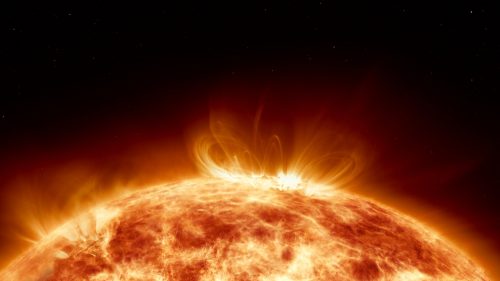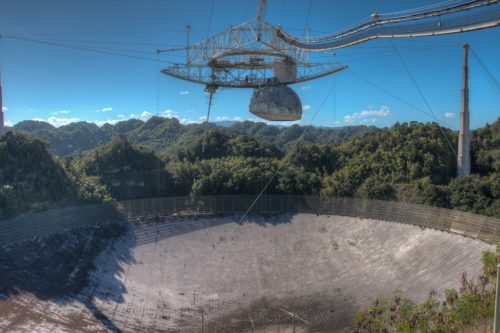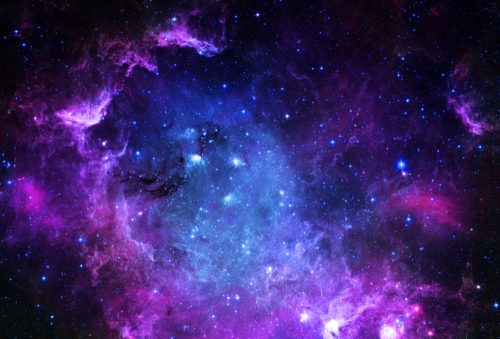25 Space Mysteries No One Can Explain

Scientists and astronomers spend all day, every day, poring over data in search of answers to the universe’s myriad questions, but they’ll be the first to admit that outer space is really, really hard—if not entirely impossible, at least for our mortal minds—to comprehend. Between all the other planets outside of Earth and two trillion galaxies besides our Milky Way, there’s a lot to untangle even about our own solar system. So given that even experts don’t exactly know what’s going on in the great beyond, it’s only natural that us earth-faring folk would have some burning questions. Below, we’re bringing you the biggest mysteries space mysteries still around.
RELATED: 30 Scary Ocean Facts More Terrifying Than Anything in Outer Space.
Mysteries of the Universe
Herein, you’ll find the most mind-numbingly, confounding mysteries from throughout the universe. So strap in, and get ready for cognitive blastoff in three….two… one!
1. Just how big is the universe?

For those who slept through astronomy, here’s a refresher: Our sun, a star, is surrounded by nine-ish (more on that later) planets. These star-planet clusters are called solar systems. Clusters of solar systems are called galaxies. The Milky Way—that’s the galaxy we’re in—is widely believed to have about 200 billion solar systems. Researchers have pegged the observable universe—that’s what we can tangibly see—at about 150 billion galaxies. Honestly, though, it could go on, and on, and on, and on, and, well, you get the point.
In fact, a team of researchers at Oxford recently deployed a model that suggests the universe is at least 250 times larger than that. To put the resulting figure in context, that’s more zeros than we can get away with typing without crashing your web browser. And that’s just galaxies. Thinking about how that number applies to solar systems, let alone planets, is enough to melt anyone’s brain.
2. So, um, where is everybody?

Yes, those staggering numbers indicate that we should’ve stumbled across alien life by now. Even if you take the most hesitant, even-keeled estimates—which come courtesy of recent Proceedings of the National Academy of Sciences research—about 1 percent of all planets in the universe are at the very least capable of fostering sustainable biological life. The folks at Wait but Why put it this way: For every single grain of sand on every single beach on Earth, there are 100 of these planets; in the Milky Way alone, there should be 100,000 intelligent civilizations. So, again, where is everybody?
Enter: The Fermi Paradox. Coined by physicist Enrico Fermi in the 1950s, the Fermi Paradox stages a valiant effort to answer this perplexing conundrum. To date, no one’s been able to solve it, but the astrological community largely splits off into two categories: that we’re the only intelligent life in existence, or that there’s an extremely good reason for why we’ve yet to discover our celestial cohabitants.
For instance, maybe we’re in a zoo-like situation, and extraterrestrial life observes us like we would a caged panda. Or perhaps we’re just in a “rural” part of the galaxy and have yet to be discovered, sort of like how 15-century explorers had no clue ancient American tribes existed before setting out across the Atlantic. Crazy, right?
3. Where is Planet 9?

Pluto is technically not a planet. But that doesn’t mean our solar system is limited to eight planets. Scientists believe that there may be a ninth, undiscovered planet on the fringes of our corner of space. If you pay attention to orbital trajectories of out-there celestial bodies, like Uranus and Neptune, you’ll notice peculiarities.
The reason is likely that there’s a massive gravitational body out there—like a planet—pulling things out of whack. According to Konstantin Batygin, assistant professor of planetary science at the California Institute of Technology, the reason we may not have found “Planet 9” yet is “because it is staggeringly dim…With the best telescopes around, we could just barely detect it, we think.”
4. What are black holes?

Black holes—galaxy-like formations where gravity levels are so powerful everything, including light, gets sucked into—remain deeply mysterious. Researchers estimate there may be as many as 100 million black holes just in the Milky Way alone. But we don’t know how they’re formed, what they do, and, crucially, what happens if matter passes through one.
5. Which came first: The black hole or the galaxy?

Among the things that baffle scientists about black holes is when they were formed in the first place. Research from astronomers examining radio-frequency pictures that provide data about early galaxies suggests the black holes may have gotten an early start. “The significant implication is that the black holes formed first and then somehow they formed a stellar galaxy around them,” said Chris Carilli, of the National Radio Astronomy Observatory in Socorro, New Mexico, one of the report’s researchers.
RELATED: 55 Fascinating World Facts You Need to Know.
6. What is dark matter?

We don’t really know what this stuff is, but scientists estimate that dark matter may make up about 25 percent of the total universe. It’s a substance that works something like a spider’s web, holding the planets, stars, and entire galaxies together. There’s plenty of evidence that it exists, but it’s a mystery what exactly it is. Maybe it’s a compound of an undiscovered particle? Maybe it’s a previously unknown property of gravity? No one’s sure.
7. How hot is dark matter?

One of the biggest questions about dark matter is about its temperature—whether it’s hot or not. Theories range from it being hot, warm, or cold, with one of the most widely accepted theories—the Lambda Cold Dark Matter model—maintaining that it is, like its nomenclature suggests, cold and dark. But the jury is still very much out.
8. What is dark energy?

In the ’90s, when a group of astrophysicists found that the universe’s expansion was speeding up due to some sort of substance counteracting gravity, they dubbed this substance “dark energy.” Believed to make up almost 70 percent or more of the known universe, theories differ on what exactly it is—a changing energy field known as “quintessence“? A property of space overlooked by Albert Einstein? It’s a whole lot of something. We’re just not sure what.
9. Where’s our second sun?

Purportedly, 80 percent of star systems are binary systems. They have two suns. Ours is not—at least not anymore. Astronomers have suggested that, once upon a time, we may have had a second sun, which has been dubbed Nemesis. More recent research, looking at a cluster of young stars in the Milky Way, finds some support for this; apparently, almost all sun-like stars are born in pairs. But unless and until we spot a star whose composition is identical to our own, Nemesis will forever remain a mystery.
10. Where did the moon come from?

You’d think we’d have this one down already. After all, we’ve actually visited the Moon’s surface. But it’s still a little foggy, even according to the experts. A popular theory is that it resulted from a huge collision of a “protoplanet” hitting the Earth around 4.5 billion years ago, and knocking off a chunk of debris. But other theories—like the relatively rote one of it being an asteroid stuck in our gravitational pull—persist. In any event, no one knows.
RELATED: 32 Greatest Scientific Discoveries of Our Lifetime.
11. What made Mercury?

Of all the planets in our solar system, Mercury may be the most mysterious. It’s so close to the Sun that terrestrial telescopes can have trouble looking at it, and what we’ve been able to gather about it has left scientists scratching their heads.
A huge metallic core represents about half the planet’s volume (Earth’s is just 10 percent, by comparison). Some theorize it used to be a planet similar in characteristics to Earth and Venus but either had its crust stripped off by a collision or boiled by the sun. Either way, when it comes to this planet, there are a lot of questions without answers.
12. Who’s the Arecibo Message going to reach?

The most powerful broadcast ever sent into space was beamed into the sky in 1974—aimed at the globular star cluster M13. The message (which consists of a graphic showing a human, our solar system, and strain of DNA, among other things) is not expected to reach its destination for about 25,000 years. But who knows: someone else might pick it up in the meantime.
13. What causes quantum entanglement?

This is when two particles mirror one another or interact in some way, even though they are separated by huge distances, even at totally different corners of the universe. Einstein called it “spooky action at a distance” and for such entanglement to be happening would require signals traveling between the particles—at a rate faster than the speed of light. This would be a pretty tough trick to pull off, but scientists have yet to find a fully satisfying explanation for the phenomenon.
14. What’s antimatter?

It’s like regular matter, but the opposite. Specifically, an antimatter particle has the same mass as a particle of matter, but with the opposite electric charge, so it destroys normal matter the moment it connects with it. While it’s believed to have been created alongside matter following the Big Bang—and still remains in the universe today—scientists don’t know exactly why. They just know we should stay far, far away from it.
15. What was around before the Big Bang?

While no one knows exactly what was out there before the Big Bang occurred, there are a few leading theories. One is that the universe simply existed in singularity, only expanding after the occurrence of the Big Bang. Other astrophysicists suspect that our early universe was actually an offspring of another, even older universe. There’s even something called the cosmic inflation theory, which states that the universe is actually eternal; it’s always existed and will continue to exist, so there is no “beginning” even to explain.
RELATED: 32 Rare Animals So Unusual, You Might Not Know They Even Exist.
16. What does “space roar” sound like?

In space, you can actually hear something scream, or at least “roar.” Researchers have detected a cacophony of radio signals that can make it hard to make out other signals being sent through space (though it would be impossible to hear with the human ear). Dale Fixsen, a University of Maryland research scientist, told Mental Floss that there are several theories for what causes this, from the possibility that the roar is coming “from the earliest stars” to “radio galaxies,” but these are still just theories.
17. How do stars explode?

When stars run out of fuel, they go out with a bang, exploding in a massive blast known as a supernova. But while research and technology such as NASA’s Nuclear Spectroscopic Telescope Array have illuminated much about the process, it still remains something of a mystery.
“Stars are spherical balls of gas, and so you might think that when they end their lives and explode, that explosion would look like a uniform ball expanding out with great power,” said Fiona Harrison, the principal investigator of NuSTAR at Caltech, upon announcing the findings in 2014. “Our new results show how the explosion’s heart, or engine, is distorted, possibly because the inner regions literally slosh around before detonating.”
18. Are cosmic rays getting worse?

High-energy particles from deep space known as “cosmic rays” have been striking the earth and may be getting worse, according to findings from NASA’s Advanced Composition Explorer spacecraft. “In 2009, cosmic ray intensities have increased 19 percent beyond anything we’ve seen in the past 50 years,” said Richard Mewaldt of Caltech. “The increase is significant, and it could mean we need to rethink how much radiation shielding astronauts take with them on deep-space missions.” But what they don’t know is exactly what’s causing this uptick or what dangers it might pose.
19. Is there a multiverse?

Any fan of Doctor Strange or the Spider-Verse movies can appreciate that, as small as we may feel in this universe, it may be only one of potentially trillions of other universes. But while there are a number of legitimate reasons—like Chaos Theory, the Butterfly Effect, or so-called “Daughter Universes”—to line up behind this idea, there is, at the moment, no way to conclusively prove it one way or another.
20. Are they “daughter” universes?

A version of the multiverse theory, this idea grows from quantum mechanics, which describes the world in terms of probabilities and suggests that all possible outcomes do occur, each a “daughter universe” sprouting from the original—but we only live in the universe where one of those outcomes occurred. “And in each universe, there’s a copy of you witnessing one or the other outcome, thinking—incorrectly—that your reality is the only reality,” writes Columbia University physicist Brian Greene. But who really knows? No one.
RELATED: 67 Weird Facts So Strange, You Won’t Believe They’re True.
21. Or are they parallel universes?

Princeton University’s Paul Steinhardt and Neil Turok, of the Perimeter Institute for Theoretical Physics in Ontario, Canada, suggested this concept, in which more dimensions exist than three of space and one of time. Greene puts it this way: “Our universe is one of potentially numerous ‘slabs’ floating in a higher-dimensional space, much like a slice of bread within a grander cosmic loaf.”
22. What lightens up the universe?

Quasars are the brightest cosmic bodies in the entire universe. Their shine comes from gas that gets sucked through black holes across different galaxies. They’re also known as the rarest objects in space. And in 1989, scientists stumbled upon something even crazier: a triple quasar. For reference, just one is able to outshine a galaxy of 100 billion stars with light, so having three of them located so closely together was a pretty massive discovery. Fortunately for us, the mass is located at a distance of 10.5 billion light-years from Earth. Phew!
23. How quickly can stars be formed?

In recent years, scientists have observed that galaxies form new stars at a rate that would appear to consume more energy than they contain. For instance, the number of stars the Milky Way produces each year is equivalent to about a sun’s worth of dust and gas. That’s not something the galaxy has enough spare matter to keep going long-term. But astronomers now suspect that these galaxies are actually recycling gas to produce new stars. If this theory holds up, then it could provide new answers to the question of missing raw matter.
24. What in the world—er, universe—is a Fermi Bubble?

Fermi bubbles were first discovered in 2010 when data from NASA’s Fermi Gamma-ray Space Telescope spotted a massive and mysterious structure in our galaxy. As indicated by the name, the feature resembled a pair of bubbles extending above and below the galaxy’s structure. Scientists suspect they are remnants of a massive burst of star formation, though no one knows for sure.
25. How will the universe end?

The Big Bang theory still remains shrouded in mystery, but that’s doubly true of the Big Crunch—the end-of-everything theory that says the universe’s ongoing expansion will eventually taper off and give way to gravity. In other words, all the mass in the universe (and potential multiverses) will be drawn together into an ever smaller space until it all exists in one unimaginably dense and hot point—and then get wiped out. Sounds unpleasant, sure, but hey! It probably won’t happen for a few quadrillion years!
Wrapping Up
That’s all we have on the mysteries of space, but be sure to check back in with us soon for more trivia! You can also sign up for our newsletter to enjoy the latest in wellness, entertainment, and travel.
- Source: https://spaceplace.nasa.gov/other-solar-systems/en/
- Source: https://www.nasa.gov/learning-resources/for-kids-and-students/what-is-a-black-hole-grades-k-4/
- Source: https://academic.oup.com/mnras/article/469/4/3881/3795556
- Source: https://www.nasa.gov/solar-system/collision-may-have-formed-the-moon-in-mere-hours-simulations-reveal/
- Source: https://nasa.gov/press/2014/february/nasas-nustar-untangles-mystery-of-how-stars-explode
- Source: https://ssed.gsfc.nasa.gov/LEADER/Science/Nuggets/2020/20200928-Rahmanifard-final.pdf
- Source: https://www.nasa.gov/missions/sounding-rockets/stars-pollute-but-galaxies-recycle/
- Source: https://svs.gsfc.nasa.gov/10688